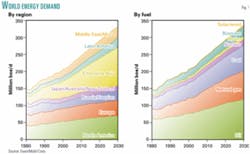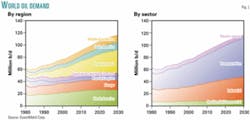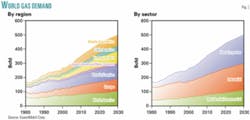Long-term changes are under way in global energy market that will affect all Americans and the US energy industry of the future, said Rex W. Tillerson, president of ExxonMobil Corp.
"Our outlook for energy demand results from what we see as likely economic growth and what we expect from continuing advances in energy efficiency," said Tillerson at a joint Dec. 8 meeting of the Independent Petroleum Association of America and the Texas Independent Producers and Royalty Owners Association in Houston. He referred to a projection of energy supply and demand through 2030 that ExxonMobil released Dec. 2.
"We see energy demand growth a bit less than 2%/year, which is about what it has been during the past 2 decades. Economic growth will actually exceed this if the world continues to be more efficient with its use of energy," he said. "Nevertheless, even with greater efficiency, the total amount of energy used by 2030 will have increased by almost two-thirds."
Most of that increase will be in oil and natural gas, which Tillerson said "will retain about three fifths of the total energy supply. Natural gas will grow at a rate slightly higher than oil and could provide one quarter of all energy by 2030."
Other energy resources
"Coal will grow more slowly than natural gas. But the emphasis on coal, of course, will be on clean-burning technology. Coal will be especially important for electricity generation in China," Tillerson said.
"Hydropower is a relatively small source [of future energy]. It is site-limited, but there will be some modest growth in China, India, and a few other developing countries. Nuclear growth is less than half of that of fossil fuels, with declining overall capacity in Europe, even if some new plants are eventually built in developed countries. The majority of the large biomass component is in the developing countries from the burning of wood and animal dung. In developed countries, there is some biomass from wood waste and garbage," said Tillerson.
He noted there is "a lot of talk" about future energy contributions from solar and wind. ExxonMobil expects supply from these sources to increase as rapidly as 10%/year.
"That's a huge compounding growth rate if you think about it against other sources of energy, largely aided by technological advances but also by government subsidies and mandates," Tillerson said. "However, even with this very high growth rate, by 2030 the share of energy supply from wind and solar will amount to less than 1% of the world's total energy demand."
null
Tillerson said, "The enormity of what our petroleum industry delivers day in and day out is not well understood by the public and, regrettably, by many policymakers. This gives rise in some circles of well-intended but misplaced views of the role that alternatives can play in the future energy picture. For example, you would need to cover [with solar power equipment] four city blocks of Manhattan to provide an energy equivalent of one very average Exxon or Mobil corner retail gas station."
Big energy market
"The world energy market is huge, and it will take a great deal of investment and a very long time before significant changes are going to be evident in the mix of energy sources that we depend upon for our economic prosperity. For the foreseeable future—and in this business, we have to see the future in terms of decades—the world economy will continue to require significant and growing supplies of crude oil and natural gas. Any notion of a silver-bullet solution for the developed economies, and particularly here in the US, is simply not realistic across this time frame," Tillerson said.
According to ExxonMobil's assessment, overall growth in world oil demand is projected at 1.5%/year through 2030. "Industrialized countries' use of oil will grow only modestly, thanks to ongoing efficiency gains as well as stable and aging populations. The fastest growing demand for oil—no surprise—comes from developing countries in Asia," Tillerson said. "The most rapid growth is associated with transportation, as a result of rising personal vehicle sales in China. Overall, transportation use of oil will double by 2030, largely due to Asian demand."
Yet even with that rapid growth, Asia still will have fewer cars per capita than the US or other industrialized countries. "Even with efficiency gains and new technology or alternative ways to generate energy, oil demand will continue to rise, such that by 2030 it could be almost 50% higher than it is today. That's a volume approaching 120 million b/d of oil. So if something is going to replace it, it's going to have to be very large," said Tillerson.
More oil needed
For at least the 3 decades and probably beyond, Tillerson said, "we will need to find and produce even more oil than we do today, a very challenging responsibility for all of us in the petroleum industry.
"Diversity of supply sources will continue to be an important principle for policymakers, and promoting access to all potential sources of new supplies is good policy for any consuming country," the ExxonMobil president said. "But for the foreseeable future, the world will be increasingly dependent upon the Organization of Petroleum Exporting Countries and the Middle East for energy."
That's not an ideological or policy choice, he said. "It is simply a reflection of where resources are to be found and how much energy will be needed to ensure continued global economic growth. There is very little that can be done to materially alter this reality with regard to conventional oil."
Tillerson expects non-OPEC production of crude and condensate to peak in the next 10 years, "with 70% of total production from seven areas—Russia, the US, the North Sea, Mexico, Canada, China, and Brazil."
He sees the call on OPEC crude supplies increasing slowly through 2010. "During this period, growth in non-OPEC supplies satisfies most of the demand growth, leaving a little room for OPEC growth. But beginning about 2010, the call on OPEC increases rapidly and will require OPEC to add more than 1 million b/d/year of capacity," Tillerson forecast. "The resources available to OPEC are adequate to accommodate this increase, and we are assuming that OPEC countries will make investments in a timely manner to meet rising demand."
Oil resource base
"Is the resource base large enough to support this outlook? We believe it is," Tillerson said, citing the US Geological Survey's estimate of 6-8 trillion bbl of oil in place, about 3 trillion bbl of it currently considered recoverable.
"I would add that the 3 trillion bbl estimate has been increased by more than 1 trillion bbl since this assessment was made in 1980, due to improvements in exploration and production technology," Tillerson said.
The industry can recover "a little more than double what it could back in the 1920s, with the biggest change coming from the development of secondary and tertiary recovery technologies," he said. "In comparison, estimates of unconventional resources also are very large. Estimates of extra-heavy oil and oil sands are more than 4 trillion bbl in place. This is expected to go up as interest in these particular resources increases. These resources are more concentrated than resources of conventional oil, with large deposits in Canada, Venezuela, Russia, and the Caspian. While resources of this type have been in production since the 1960s the amount of cumulative production to date is very small.
"Shale oil, another very large unconventional resource, has not received much attention since the 1970s. Oil shale deposits are estimated to be in excess of 3 trillion bbl. Like extra-heavy oil and oil sands, high-quality oil shale tends to be somewhat highly concentrated. The largest known deposit is the Green River formation in the western US, with over 1.5 trillion bbl of equivalent oil in place," said Tillerson, noting that development of those resources is dependent on emerging technologies.
Natural gas outlook
Tillerson said overall growth in demand for natural gas through 2003 will be about 2.2%/year—"the fastest among the major fuel forms." Demand growth will be fastest in Asia-Pacific. Worldwide, electric power generation will account for about half of the period's gas demand growth.
ExxonMobil expects gas trade between regions to continue to grow, with its share of total supply rising from 8% this year to 22% in 2030, when exported gas will amount to nearly 110 bcfd. LNG will supply most of the increase, representing about 14% of total supply in 2020 and more in 2030.
Europe's import dependence will rise from about 40% today to 70% in 2030, Tillerson said. "Pipeline supplies from Russia and the Caspian region and from North Africa, mainly from Algeria, will continue to represent the main source of imports, although LNG's share also is expected to grow."
Gas imports by North America and the Asia-Pacific region will grow by 2030, according to the ExxonMobil outlook, with LNG increasingly important in both regions.
"Providing the enormous increase in global LNG that will be needed will be very extensive," Tillerson said, noting that the International Energy Agency estimates LNG investments will total $250 billion through 2030. "When coupled with investments required for all other energy needs, this will present challenges to finance the incredible amount of energy infrastructure that will be needed."
Tillerson said the US will need gas from both LNG and the Arctic, although each source presents challenges.
He said ExxonMobil is among companies discussing potential terminals on the Gulf Coast. "The public issues are significant, but we are confident they can be successfully addressed," he said.
Any new growth segment increases cost pressures that eventually can be reduced through technology development, said Tillerson. "Already we've seen significant reductions in the costs of supplying LNG through larger scale onshore facilities and larger ships," he said. "We still have a fair amount of work to do to help governments and the public to understand that LNG is needed, can be supplied safely, and is a source of new reliable and affordable energy for this country."
Investment needs
Tillerson pointed to the "enormous" investments the industry must make to meet future energy needs. "It will place a premium on being smart about the investments we make," he said.
"Second and related to this is the need to skillfully manage the commercial and political risks of these large investments, both in the developing world as well as in the consuming markets and industrialized countries. However, this is not a new challenge, and it's one our industry is well equipped to handle," he said.
The industry needs access to new segments of the global petroleum resource. In 2020, Tillerson noted, more than three quarters of oil and gas supply will have to come from new fields and new developments.
Tillerson underscored "the importance of having stable and clear financial arrangements for major resource project developments. This stability is particularly important for large-scale investments associated with LNG, arctic gas, and the large infrastructure requirements."
He said, "None of this is going to be easy. It will require a considerable amount of exploration skill, negotiation, technological competence, and management expertise, as well as continued advancements in new technology. But it can—indeed, it must—be done."



